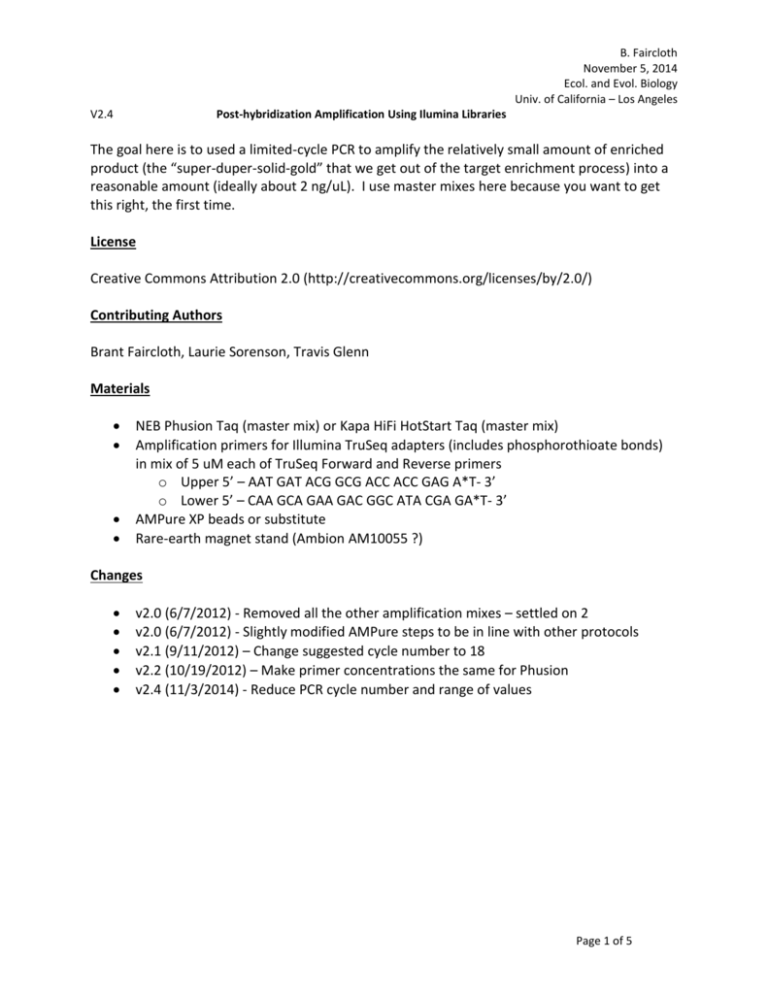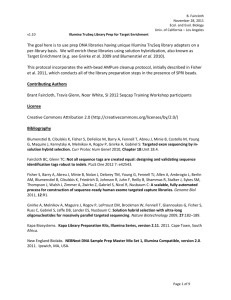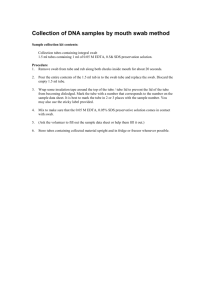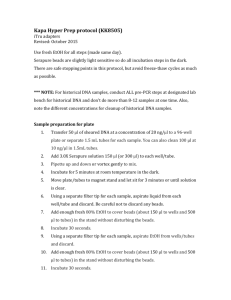B. Faircloth November 5, 2014 Ecol. and Evol. Biology Univ. of
advertisement

B. Faircloth November 5, 2014 Ecol. and Evol. Biology Univ. of California – Los Angeles V2.4 Post-hybridization Amplification Using Ilumina Libraries The goal here is to used a limited-cycle PCR to amplify the relatively small amount of enriched product (the “super-duper-solid-gold” that we get out of the target enrichment process) into a reasonable amount (ideally about 2 ng/uL). I use master mixes here because you want to get this right, the first time. License Creative Commons Attribution 2.0 (http://creativecommons.org/licenses/by/2.0/) Contributing Authors Brant Faircloth, Laurie Sorenson, Travis Glenn Materials NEB Phusion Taq (master mix) or Kapa HiFi HotStart Taq (master mix) Amplification primers for Illumina TruSeq adapters (includes phosphorothioate bonds) in mix of 5 uM each of TruSeq Forward and Reverse primers o Upper 5’ – AAT GAT ACG GCG ACC ACC GAG A*T- 3’ o Lower 5’ – CAA GCA GAA GAC GGC ATA CGA GA*T- 3’ AMPure XP beads or substitute Rare-earth magnet stand (Ambion AM10055 ?) Changes v2.0 (6/7/2012) - Removed all the other amplification mixes – settled on 2 v2.0 (6/7/2012) - Slightly modified AMPure steps to be in line with other protocols v2.1 (9/11/2012) – Change suggested cycle number to 18 v2.2 (10/19/2012) – Make primer concentrations the same for Phusion v2.4 (11/3/2014) - Reduce PCR cycle number and range of values Page 1 of 5 B. Faircloth November 5, 2014 Ecol. and Evol. Biology Univ. of California – Los Angeles V2.4 Post-hybridization Amplification Using Ilumina Libraries Steps Here, I provide instructions using several different polymerases/master mixes/kits. You may want to set up several reactions – a test reaction or two at 25 uL total volume to test amplification and a “final” large 50 uL amplification that will be the template you carry over for sequencing. Kapa HiFi HotStart Master Mix (50 uL reaction) 1. Setup the following PCR reactions in separate 0.2 mL tubes. You can master mix these for multiple tubes/reactions: 25 uL 2X Kapa HiFi HS RM 5 uL Primer Mix (5 uM each of TruSeq Forward and Reverse primers) 15 uL Adapter-ligated DNA 5 uL ddH20 50 uL Total volume 2. Cycle using the following. You may need to adjust or optimize cycle number (might consider 12-16 cycles. Do not go over 18-20 cycles if possible.): 98 C for 45 seconds => 12-16 cycles of: 98 C for 15 seconds 60 C for 30 seconds 72 C for 60 seconds => 72 C for 5 minutes => 4 C 3. Allow AMPure beads to warm to room temperature for 30 minutes. Page 2 of 5 B. Faircloth November 5, 2014 Ecol. and Evol. Biology Univ. of California – Los Angeles V2.4 Post-hybridization Amplification Using Ilumina Libraries NEB Phusion DNA Polymerase (50 uL reaction) 1. Setup the following PCR reactions in separate 0.2 mL strip-tubes or plates: 5 uL ddH2O 25 uL Phusion HF Master Mix 5 uL Primer Mix (5 uM each of TruSeq Forward and Reverse primers) 15 uL Template DNA (from Step 68 above) 50 uL Total volume 2. Cycle using the following. You may need to adjust or optimize cycle number (might consider 13-17cycles but do not go over 18-20 cycles if possible): 98 C for 30 seconds => 13-17 cycles of: 98 C for 10 seconds 65 C for 30 seconds 72 C for 60 seconds => 72 C for 5 minutes => 4 C 3. Allow AMPure beads to warm to room temperature for 30 minutes. Page 3 of 5 B. Faircloth November 5, 2014 Ecol. and Evol. Biology Univ. of California – Los Angeles V2.4 Post-hybridization Amplification Using Ilumina Libraries AMPure Cleanup 4. Vortex or shake AMPure beads until they are homogenous and resemble well-mixed chocolate milk. 5. Prepare sufficient, fresh 70% EtOH for each of the samples. You need about 1000 uL each sample. Freshness of EtOH is critical to AMPure success. 6. Transfer your PCR mix (which should be brown because it contains streptavidin beads) to a clean 1.5 mL tube. 7. Place 1.5 mL tube on magnetic separator until solution is clear. 8. Transfer supernatant to a new 1.5 mL tube. You can throw away the tube that contains the remaining streptavidin beads. 9. In a 1.5 mL tube, combine PCR product and 90 uL AMPure XP beads (1.8X). Mix by pipetting or vortexing. 10. Incubate the mixture for 5 minutes at room temperature. 11. Move 1.5 mL tubes to a rare-earth magnet stand. 12. Let sit for about 3 minutes or until solution is clear. 13. Using a separate filter-tip for each 1.5 mL tube, aspirate liquid from tubes and discard. 14. Add 200 uL 70% EtOH to each tube in the stand. 15. Incubate 30 seconds. 16. Using a separate filter-tip for each 1.5 mL tube, aspirate EtOH from tubes and discard. 17. Add 200 uL 70% EtOH to each tube in the stand. 18. Incubate 30 seconds. 19. Using a separate filter-tip for each 1.5 mL tube, aspirate EtOH from tubes and discard. 20. Allow the tubes containing the AMPure beads to dry for approximately 5 minutes or until there is no longer a smell of EtOH. You do not want the AMPure beads to appear “cracked” or “crusty”. In my experience, it takes about 7 minutes for tubes to air-dry in a low humidity environment. Do not dry on a heat block. Use sterile toothpicks to remove EtOH blobs. 21. Remove the 1.5 mL tube from the rare-earth magnet stand and add 22 uL ddH2O. 22. Mix beads and water by pipetting up and down. 23. Gently and slowly (< 2000 RPM) spin tubes for 2-3 seconds. Page 4 of 5 B. Faircloth November 5, 2014 Ecol. and Evol. Biology Univ. of California – Los Angeles V2.4 Post-hybridization Amplification Using Ilumina Libraries 24. Place tubes back on magnet stand and aspirate liquid into clean 1.5 mL microtubes. Because we’re using AMPure, we’ll get out almost or exactly what we put in, so set your pipet on 31-32 uL. 25. Discard leftover tubes containing AMPure beads. 26. Quantify a 1-2 uL aliquot of the enriched, cleaned library using the Qubit. 27. [Optional] You may wish to run an additional PCR to ensure that you actually enriched your target loci relative to the unenriched “controls”. BCF has primers available. 28. [Optional] Quantify libraries using qPCR (Kapa Library Quantification kit). 29. Combine libraries at equimolar ratios dependent on your needs or those of the sequencing center. If you are using the 5k locus set and a HiSeq 2000 with v3 sequencing chemistry, then you can successfully pool up to 96 libraries. Page 5 of 5







